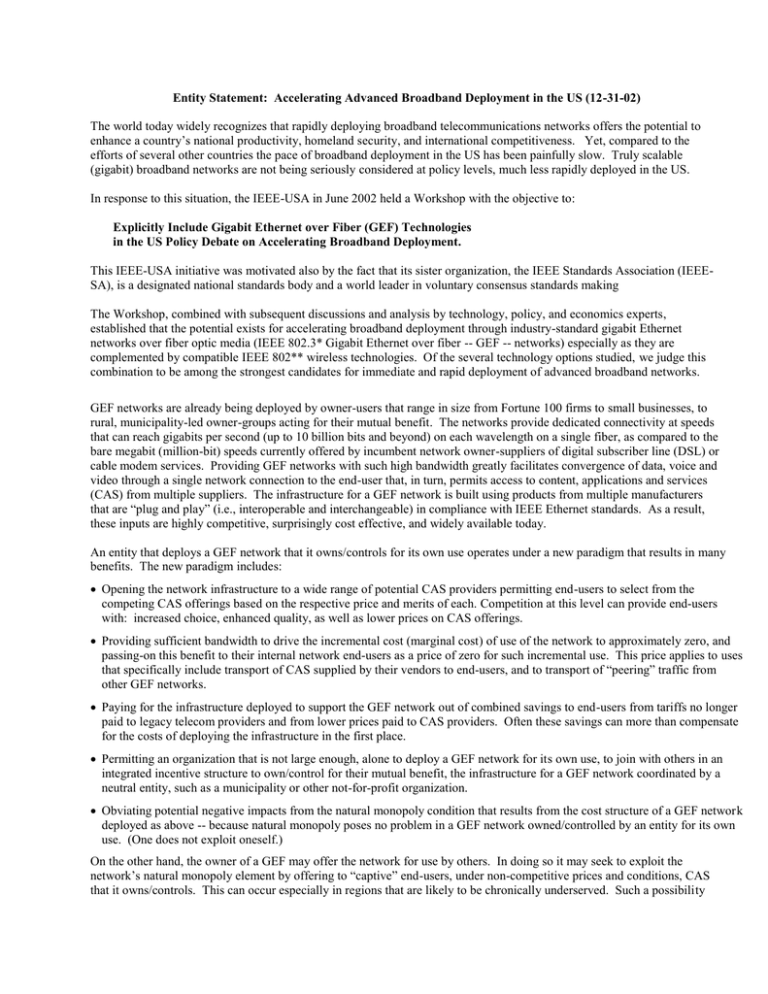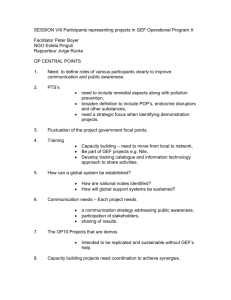Entity Statement: Accelerating Advanced Broadband Deployment in the US...
advertisement

Entity Statement: Accelerating Advanced Broadband Deployment in the US (12-31-02) The world today widely recognizes that rapidly deploying broadband telecommunications networks offers the potential to enhance a country’s national productivity, homeland security, and international competitiveness. Yet, compared to the efforts of several other countries the pace of broadband deployment in the US has been painfully slow. Truly scalable (gigabit) broadband networks are not being seriously considered at policy levels, much less rapidly deployed in the US. In response to this situation, the IEEE-USA in June 2002 held a Workshop with the objective to: Explicitly Include Gigabit Ethernet over Fiber (GEF) Technologies in the US Policy Debate on Accelerating Broadband Deployment. This IEEE-USA initiative was motivated also by the fact that its sister organization, the IEEE Standards Association (IEEESA), is a designated national standards body and a world leader in voluntary consensus standards making The Workshop, combined with subsequent discussions and analysis by technology, policy, and economics experts, established that the potential exists for accelerating broadband deployment through industry-standard gigabit Ethernet networks over fiber optic media (IEEE 802.3* Gigabit Ethernet over fiber -- GEF -- networks) especially as they are complemented by compatible IEEE 802** wireless technologies. Of the several technology options studied, we judge this combination to be among the strongest candidates for immediate and rapid deployment of advanced broadband networks. GEF networks are already being deployed by owner-users that range in size from Fortune 100 firms to small businesses, to rural, municipality-led owner-groups acting for their mutual benefit. The networks provide dedicated connectivity at speeds that can reach gigabits per second (up to 10 billion bits and beyond) on each wavelength on a single fiber, as compared to the bare megabit (million-bit) speeds currently offered by incumbent network owner-suppliers of digital subscriber line (DSL) or cable modem services. Providing GEF networks with such high bandwidth greatly facilitates convergence of data, voice and video through a single network connection to the end-user that, in turn, permits access to content, applications and services (CAS) from multiple suppliers. The infrastructure for a GEF network is built using products from multiple manufacturers that are “plug and play” (i.e., interoperable and interchangeable) in compliance with IEEE Ethernet standards. As a result, these inputs are highly competitive, surprisingly cost effective, and widely available today. An entity that deploys a GEF network that it owns/controls for its own use operates under a new paradigm that results in many benefits. The new paradigm includes: Opening the network infrastructure to a wide range of potential CAS providers permitting end-users to select from the competing CAS offerings based on the respective price and merits of each. Competition at this level can provide end-users with: increased choice, enhanced quality, as well as lower prices on CAS offerings. Providing sufficient bandwidth to drive the incremental cost (marginal cost) of use of the network to approximately zero, and passing-on this benefit to their internal network end-users as a price of zero for such incremental use. This price applies to uses that specifically include transport of CAS supplied by their vendors to end-users, and to transport of “peering” traffic from other GEF networks. Paying for the infrastructure deployed to support the GEF network out of combined savings to end-users from tariffs no longer paid to legacy telecom providers and from lower prices paid to CAS providers. Often these savings can more than compensate for the costs of deploying the infrastructure in the first place. Permitting an organization that is not large enough, alone to deploy a GEF network for its own use, to join with others in an integrated incentive structure to own/control for their mutual benefit, the infrastructure for a GEF network coordinated by a neutral entity, such as a municipality or other not-for-profit organization. Obviating potential negative impacts from the natural monopoly condition that results from the cost structure of a GEF network deployed as above -- because natural monopoly poses no problem in a GEF network owned/controlled by an entity for its own use. (One does not exploit oneself.) On the other hand, the owner of a GEF may offer the network for use by others. In doing so it may seek to exploit the network’s natural monopoly element by offering to “captive” end-users, under non-competitive prices and conditions, CAS that it owns/controls. This can occur especially in regions that are likely to be chronically underserved. Such a possibility can be foreclosed, however, by regulations requiring that when supplying its GEF to others, each such network-supplier act only as a carrier of CAS, i.e., that it be prohibited from exercising market power by providing to client-end-users CAS that it owns/controls. Conclusions The endeavor of the Workshop established that the resources required for accelerating US broadband deployment exist in the form of GEF, gigabit bandwidth networks that allow for early, rapid growth plus the high likelihood of meeting future user requirements – even those that are as yet unforeseen. Operating such networks and providing CAS over such networks are matters that are well understood. GEF networks are ready for rapid deployment. The endeavor of the Workshop also arrived at the important conclusion that GEF networks represent an inherently disruptive innovation. Their deployment is, therefore, having and is likely to continue to have direct impact on the business models of current telecom providers. Rapid, wide deployment of GEF networks could well lead to a tumultuous transition period as the functioning of a competitive market drives the price of services offered over the networks of incumbents to their marginal costs. Although GEF networks are already being deployed by leading-edge end-users in the private and public sectors throughout North America and abroad, at this early stage in the US, GEF networks are vulnerable to being blocked through non-market, anti-competitive tactics of rivals. The tradeoffs between the costs to the economy of such an interference with market forces, as compared to those from the stresses of a possible, rapid transition to a disruptive technology in response to market forces, demand careful monitoring, penetrating analysis, and levelheaded, steady stewardship – in the context of creative leadership. Accordingly we of the IEEE-USA recommend: Recommendation 1 Policymakers must ensure that IEEE 802.3, Gigabit Ethernet over fiber (GEF) technologies complemented by IEEE 802 wireless technologies be fully considered and fairly evaluated for a prominent role in accelerating broadband deployment in the US. Recommendation 2 Government policies at the FCC, DOJ, and FTC, as well as at state and local regulatory and enforcement agencies throughout the US, must be established, and actions must be taken to ensure that IEEE 802.3 Gigabit Ethernet over fiber and complementary IEEE 802 wireless networks are given a fair marketplace opportunity to prove themselves on their merits as contributors to enhancing the country’s national productivity, homeland security, and international competitiveness. This will require that possible, nonmarket, anticompetitive blocking actions by rivals be foreclosed. Recommendation 3 Government policies at the FCC, DOJ, and FTC, as well as at state and local regulatory and enforcement agencies throughout the US, must ensure that if an entity owns/controls an advanced broadband network and offers it for use by others, then it must do so under legal or regulatory constraints that require it to function only as a carrier of CAS, i.e., that it be prohibited from exercising market power by providing to its clientend-users CAS that it owns/controls. Recommendation 4 Government policies at the FCC, DOJ, and FTC, as well as at state and local regulatory and enforcement agencies throughout the US, must also ensure that marketplaces are not foreclosed to appropriate opportunities for today’s incumbents to participate in the new paradigm, perhaps through imaginative, new business models and/or in different, particular stages of the industry. As a nation, we must ensure that these recommendations are addressed on a timely basis. Our national productivity, homeland security, and international competitiveness may well depend on it. This statement was developed by the IEEE-USA's Committee on Communications and Information Policy and represents the considered judgment of a group of U.S. IEEE members with expertise in the subject field. IEEE-USA is an organizational unit of The Institute of Electrical and Electronics Engineers, Inc., created in 1973 to promote the careers and public-policy 2 interests of the more than 235,000 electrical, electronics, computer and software engineers who are U.S. members of the IEEE. ***** End Notes * IEEE 802.3, a Working Group of IEEE 802, has worldwide recognition as the Ethernet standardization leader. ** The IEEE 802® LAN/MAN Standards Committee encompasses many evolving wired and wireless local and metropolitan area network technologies. Access standards complementary to IEEE 802.3 are being developed in IEEE 802 Working Groups: 802.11, Wireless Local Area Networks ("Wi-Fi"), 802.16, Broadband Wireless Access (BWA); and 802.17, Resilient Packet Ring (RPR);” and 802.20, Mobile Broadband Wireless Access (MBWA). 3


